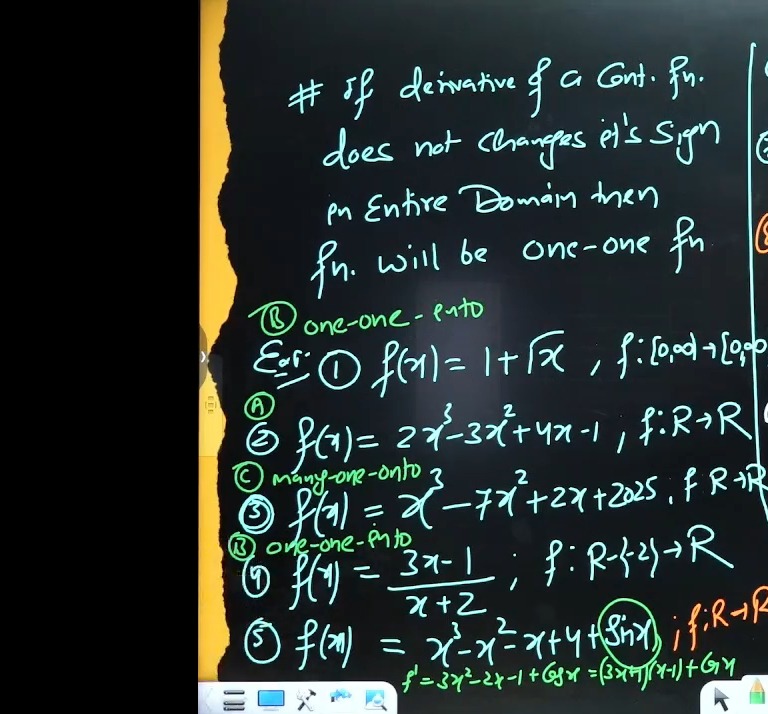Question
Question: If the derivative of a continuous function does not change its sign on its entire domain, then the f...
If the derivative of a continuous function does not change its sign on its entire domain, then the function will be one-one.

A
one-one-ento
B
f(x)=1+sqrt(x), f:[0,inf) -> [0,inf)
C
f(x)=2x^3-3x^2+4x-1, f:R -> R
D
f(x)=x^3-7x^2+2x+2025, f:R -> R
E
f(x)=(3x-1)/(x+2); f:R-{2}->R
F
f(x)=x^3-x^2-x+4+(sinx), f:R->R
Answer
The statement is correct. A continuous function whose derivative does not change sign on its domain is strictly monotonic, and therefore one-to-one. For the given examples:
- f(x)=1+x on [0,∞) has f′(x)=2x1>0 for x>0. It is one-to-one but not onto as its range is [1,∞) while codomain is [0,∞).
- f(x)=2x3−3x2+4x−1 on R has f′(x)=6x2−6x+4. The discriminant is (−6)2−4(6)(4)=36−96=−60<0. Since the leading coefficient is positive, f′(x)>0 for all x∈R. It is strictly increasing and thus one-to-one. As a cubic polynomial, its range is R, so it is also onto.
- f(x)=x3−7x2+2x+2025 on R has f′(x)=3x2−14x+2. This quadratic has real roots, so f′(x) changes sign. Thus, f(x) is not one-to-one.
- f(x)=x+23x−1 on R−{2} has f′(x)=(x+2)27>0 for x=−2. It is one-to-one.
- f(x)=x3−x2−x+4+(sinx) on R has f′(x)=3x2−2x−1+cosx. f′(0)=0 and f′′(0)=−2, indicating f′(x) changes sign. Thus, f(x) is not one-to-one.
Explanation
Solution
A function is one-to-one if its derivative does not change sign over its domain.
- f(x)=1+x: f′(x)=2x1>0 for x>0. One-to-one.
- f(x)=2x3−3x2+4x−1: f′(x)=6x2−6x+4. Discriminant Δ<0 and leading coefficient >0, so f′(x)>0. One-to-one.
- f(x)=x3−7x2+2x+2025: f′(x)=3x2−14x+2. Roots exist, derivative changes sign. Not one-to-one.
- f(x)=x+23x−1: f′(x)=(x+2)27>0 for x=−2. One-to-one.
- f(x)=x3−x2−x+4+(sinx): f′(x)=3x2−2x−1+cosx. f′(0)=0 and f′′(0)=−2, so derivative changes sign. Not one-to-one.
The functions that are one-to-one are ①, Ⓐ, and Ⓑ.
